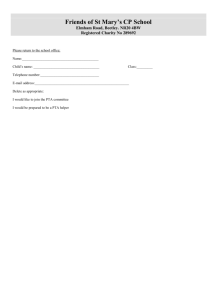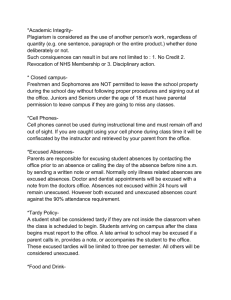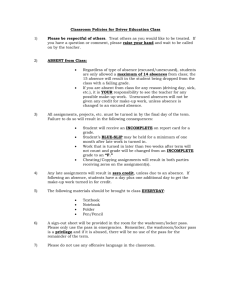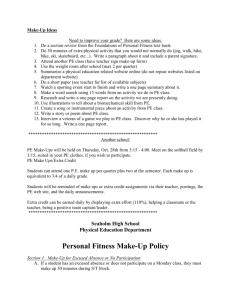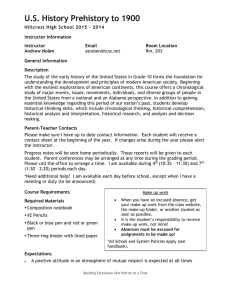MARTIN COMMUNITY COLLEGE
advertisement
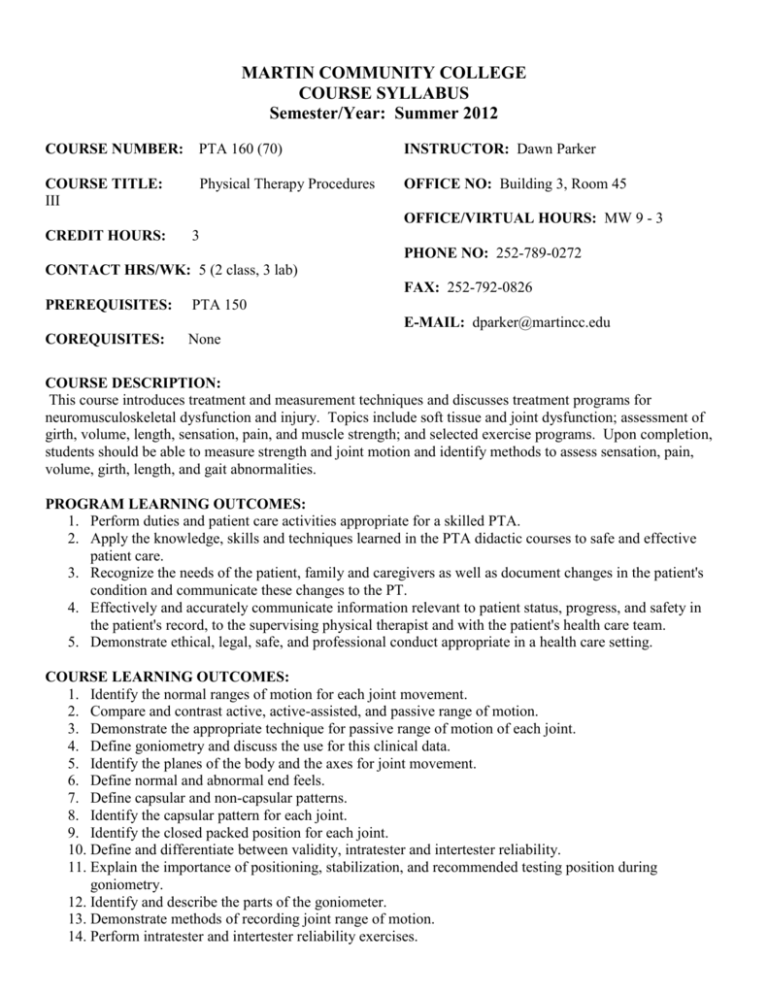
MARTIN COMMUNITY COLLEGE COURSE SYLLABUS Semester/Year: Summer 2012 COURSE NUMBER: PTA 160 (70) INSTRUCTOR: Dawn Parker COURSE TITLE: III Physical Therapy Procedures OFFICE NO: Building 3, Room 45 OFFICE/VIRTUAL HOURS: MW 9 - 3 CREDIT HOURS: 3 PHONE NO: 252-789-0272 CONTACT HRS/WK: 5 (2 class, 3 lab) FAX: 252-792-0826 PREREQUISITES: PTA 150 COREQUISITES: None E-MAIL: dparker@martincc.edu COURSE DESCRIPTION: This course introduces treatment and measurement techniques and discusses treatment programs for neuromusculoskeletal dysfunction and injury. Topics include soft tissue and joint dysfunction; assessment of girth, volume, length, sensation, pain, and muscle strength; and selected exercise programs. Upon completion, students should be able to measure strength and joint motion and identify methods to assess sensation, pain, volume, girth, length, and gait abnormalities. PROGRAM LEARNING OUTCOMES: 1. Perform duties and patient care activities appropriate for a skilled PTA. 2. Apply the knowledge, skills and techniques learned in the PTA didactic courses to safe and effective patient care. 3. Recognize the needs of the patient, family and caregivers as well as document changes in the patient's condition and communicate these changes to the PT. 4. Effectively and accurately communicate information relevant to patient status, progress, and safety in the patient's record, to the supervising physical therapist and with the patient's health care team. 5. Demonstrate ethical, legal, safe, and professional conduct appropriate in a health care setting. COURSE LEARNING OUTCOMES: 1. Identify the normal ranges of motion for each joint movement. 2. Compare and contrast active, active-assisted, and passive range of motion. 3. Demonstrate the appropriate technique for passive range of motion of each joint. 4. Define goniometry and discuss the use for this clinical data. 5. Identify the planes of the body and the axes for joint movement. 6. Define normal and abnormal end feels. 7. Define capsular and non-capsular patterns. 8. Identify the capsular pattern for each joint. 9. Identify the closed packed position for each joint. 10. Define and differentiate between validity, intratester and intertester reliability. 11. Explain the importance of positioning, stabilization, and recommended testing position during goniometry. 12. Identify and describe the parts of the goniometer. 13. Demonstrate methods of recording joint range of motion. 14. Perform intratester and intertester reliability exercises. 15. Demonstrate Range of Motion assessment of any joint including: a. a clear explanation of the assessment procedure b. proper patient positioning c. adequate stabilization d. palpation of the correct bony landmarks e. correct alignment of the goniometer or other measuring device f. accurate reading and recording 16. Discuss possible alternatives for patient positioning. 17. Identify common substitution patterns. 18. Assess skin color, condition, and circulation. 19. Demonstrate and explain techniques for assessment of leg length, segmental length, girth, and volume. 20. Explain and perform sensory assessment in upper and lower extremity dermatomes. 21. Explain and demonstrate assessment of myotomes and dermatomes. 22. Explain the correlation of myotome, dermatome, and DTR testing in a patient with a nerve injury. 23. Explain the grading system used for manual muscle testing. 24. Discuss the importance of stabilization during manual muscle testing. 25. Discuss the limitations and objectivity of manual muscle testing 26. Demonstrate manual muscle testing for the major musculature of the extremities and trunk including: a. clear explanation of the assessment procedure b. proper patient and PTA positioning c. adequate stabilization d. palpation of the musculature which is being tested e. accurate assessment and recording of the muscle grade 27. Identify the prime movers for joint motions, following a review of the origins, insertions, actions, and innervation of the muscles being tested. REQUIRED TEXTBOOKS: (1)Daniels and Worthingham (2007). Muscle testing: techniques of manual examination (8th ed.). St. Louis: Saunders. ISBN: 1-4160-2350-X. (2)Norkin, Cynthia (2009). Measurement of joint motion, a guide to goniometry (4th ed.). Philadelphia: F.A. Davis. ISBN: 0-8036-0972-8. (3)O'Sullivan and Schmitz (2007). Physical Rehabilitation (5th ed.). Philadelphia: F.A. Davis. ISBN: 0-8036-1247-8. SUPPLEMENTAL RESOURCES: None LEARNING/TEACHING METHODS: Lecture, Audio Visuals, Power Point Presentations, Internet, Outside Reading Assignments. ASSESMENTS/METHODS OF EVALUATION: 1. Written exams: 60% 2. Practical exams: 40% 3. Muscle, Landmark Quizzes; Outside Reading Assignments: Will be averaged for a written exam grade. GRADING POLICY: A = 100-93 B = 92-85 C = 84-77 D = 76-69 F = 68 or below Students must maintain at least an average of 77% in this class to remain in the PTA Program. COURSE OUTLINE: WEEK ONE: WEEK TWO : WEEK THREE: WEEK FOUR: WEEK FIVE: Goniometry: Basic Concepts, Procedures, Validity and Reliability The Shoulder The Elbow and Forearm Goniometry: The Wrist The Hand Goniometry: The Hip and Knee The Ankle and Foot The Cervical Spine The Thoracic and Lumbar Spine The Temporomandibular Joint Sensation Testing Skin and Volumetric Measurements Girth Measurements Manual Muscle Testing: Principles Testing of the Neck Testing of the Trunk Manual Muscle Testing: Testing of the Upper Extremity Manual Muscle Testing: Testing of the Lower Extremity Assessment of the Muscles Innervated by the Cranial Nerves Upright Motor Control Gait Abnormalities STUDENT ATTENDANCE POLICY: The College has a specific absence policy for all courses, which states that students are expected to attend a minimum of 80% of the total hours of the course, which includes classes, labs, and shops. Students must be present at least one class during the first 10% of a course in order to be considered enrolled in the class. If a student has not attended at least one class by the 10% census date, the instructor will administratively withdraw the student. This program abides by the MCC policy. When an absence is unavoidable in a program course, the student is to notify the class instructor by telephone prior to the scheduled class time as to the reason for the absence. Upon return, the student is to meet personally with that instructor to discuss the class(es) missed and identify make-up work. This is the student's responsibility and must be done in a timely manner. Experience has shown that a person with frequent absences or tardy arrivals as a student demonstrates this same behavior as a worker. A potential employer usually inquires as to the student's behavior in regard to absences or tardiness as it reflects a possible problem as a worker. In a physical therapy department, workers depend on each other to be present and on time to get the work done without imposing a hardship or overload on others. The PTA Program is preparing you to be employed in physical therapy departments. We want you to be dependable and reliable as employees, thus as students. In compliance with G.S. 115D-5, MCC policy permits a student to be excused, with the opportunity to make-up any test or other missed work, a minimum of two excused absences per academic year for religious observances required by the student’s faith. The policy limits the excused absences to a maximum of two days per academic year. Students who wish to be excused for a Religious Observance required by their faith must complete and submit a request form to the instructor(s) prior to the census date of each class. The Request for Excused Absences for Religious Observances form can be picked up from Student Services. This does not supersede the college-wide attendance policy as outlined in the college catalog or syllabus, with the exception of a reasonable accommodation for the make-up of missed course work. COURSE POLICIES: Make-up Policy: Make-up exams are allowed at the discretion of the instructor. Contact the instructor BEFORE the exam. Exams will be taken on the first day you return to class following an EXCUSED absence. Assignments are due on the date assigned. A letter grade will be deducted for each day that an assignment is late. There will be NO make-up quizzes. Ethical Violation: Any student found cheating on an exam will receive a "F" for the course, and be dismissed from the program. Plagiarism: Any student caught plagiarizing a paper will receive a zero for the assignment and possible disciplinary action. Professional Behavior: Throughout this course, students will be treated as, and will be expected to behave as, future physical therapy colleagues. All students will refrain from inappropriate behavior during lectures and labs (talking, arriving late/leaving early, allowing cell phones to ring, checking email/using internet on personal laptop, etc.). Please treat instructors and fellow classmates with respect. Cell Phones: Cell phones must be kept on silent or vibrate during class. There is to be NO texting during class, and if you MUST answer your phone, you should excuse yourself from the class quietly. ALL phones are to be turned off during exams, practicals, and presentations. A phone causing a disturbance during an exam, practical, or presentation may result in the loss of a letter grade. If you cannot reach your instructor, you may contact the Dean of Academic Affairs and Student Services at 252-789-0246. If you have a need for a disability-related accommodation, please notify the Student Services counselor at 252-789-0293.

